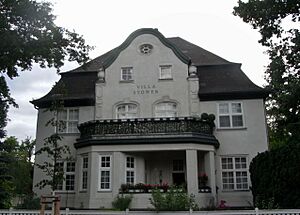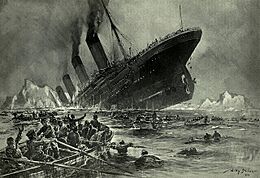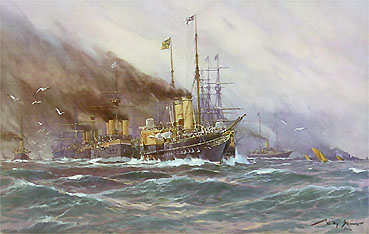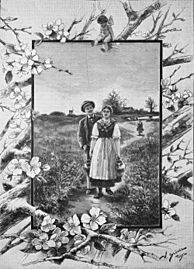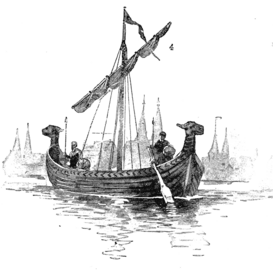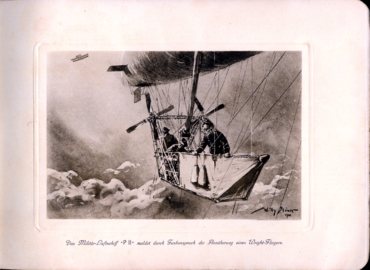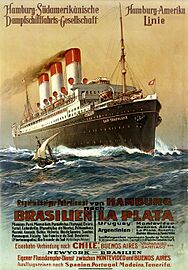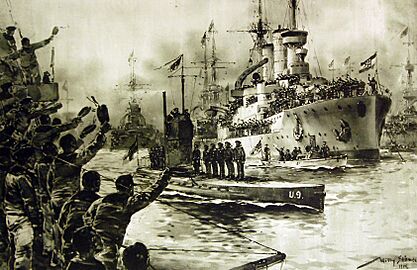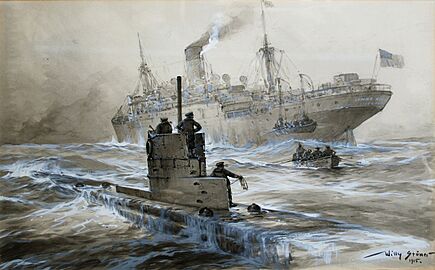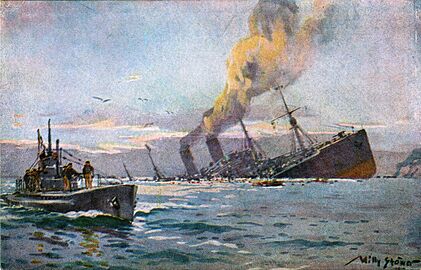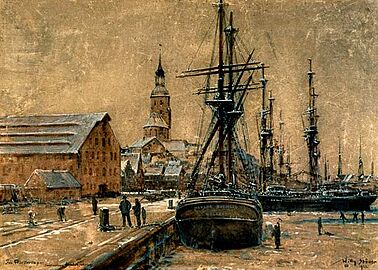Willy Stöwer facts for kids
Quick facts for kids
Willy Stöwer
|
|
|---|---|
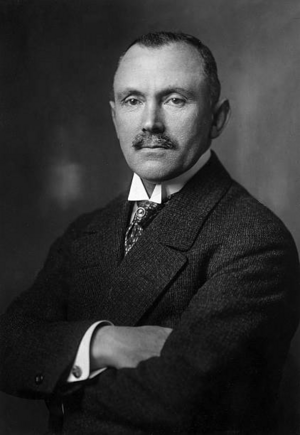
Stöwer in 1913
|
|
| Born |
Wilhelm Christian Friedrich Stöwer
22 May 1864 Wolgast, Prussian province of Pomerania
|
| Died | 31 May 1931 (aged 67) Berlin-Tegel, Weimar Republic
|
| Nationality | German |
| Education | self-taught |
| Known for | Naval art, Imperial German period Commercial art |
|
Notable work
|
Der Untergang der „Titanic‟ |
| Spouse(s) |
Henrietta Dettmann
(m. 1898) |
| Patron(s) | Kaiser Wilhelm II |
| Signature | |
Willy Stöwer (born May 22, 1864 – died May 31, 1931) was a German artist, illustrator, and writer. He lived during the time of the German Empire. Stöwer is most famous for his paintings of ships and the sea, and his printed pictures called lithographs. Many of his artworks show important events from history, like the sinking of the RMS Titanic in 1912.
Life of Willy Stöwer
Willy Stöwer was born in Wolgast, Germany. His father was a sea captain. Wolgast is a town located on the Baltic coast.
He first trained to be a metalworker. Later, he worked as a technician in engineering offices at different German shipyards. Soon, people started asking him to create drawings, illustrations, and paintings. His talent was noticed early on. He learned how to paint all by himself. In 1892, he married Henrietta Dettmann, who came from a wealthy family. This allowed him to focus only on his art.
Kaiser Wilhelm II, the German Emperor, became a big fan of Stöwer's art. He supported Stöwer, and many said Stöwer was the Kaiser's favorite naval painter. Stöwer even traveled with the Emperor on several sea trips between 1905 and 1912. He was also a member of the board for the German Navy League. In 1907, he was given the special title of an honorary professor.
Stöwer's career was closely linked to the Kaiser and the Imperial German Navy. After the Kaiser stepped down and the Imperial era ended, Stöwer's most creative period also finished. He didn't have the Kaiser's support anymore. Later in his career, he mostly got jobs from steamship companies. He passed away quietly at his home in Berlin-Tegel on May 31, 1931. This was nine days after his 67th birthday. Stöwer is buried in a cemetery in Berlin, and his grave is still there today.
Stöwer's Art Career
Willy Stöwer was a very busy artist between 1892 and 1929. He created around 900 black-and-white and 335 color pictures for 57 books. He also designed posters, postcards, trading cards, labels, brochures, and calendars.
One of his early works for businesses was a set of trading cards. He made these cards for the German chocolate company Stollwerck from 1899 to 1900. The series was called The New German Warships.
Stöwer became especially well-known for his picture of the sinking of the RMS Titanic. This illustration appeared in the magazine Die Gartenlaube. He drew it shortly after the disaster in 1912, without having all the exact details. For example, the fourth funnel on the Titanic was only for ventilation and didn't produce black smoke. However, this image became very famous and has been printed many times, even now.
Stöwer was not known for painting portraits of people. But he did paint a portrait of the Kaiser in a naval uniform. This painting, along with some of his naval artworks, hangs in the Kaiser's Room at Achilleion. This was the Kaiser's summer palace from 1907 to 1914, located on the Island of Corfu. Today, Achilleion is a museum.
Other examples of Stöwer's art can be found in museums. His oil on canvas painting, Sinking of the Italian destroyer "Turbine" by Austrian destroyers on 24 May 1915, is at the Military History Museum in Vienna. His painting, Speedboat ahead! is at the International Maritime Museum of Hamburg. In 1917, postcards were made from some of his paintings. These were sold to raise money to help wounded U-boat crew members and the families of those who died during World War I.
Gallery
- Willy Stöwer examples in various media (with associated text translated)
-
Book illustration (1902)
"Lübeck ship"
From Hanseatic League Ships of the 14th and 15th Centuries -
Poster (around 1913)
Cap Trafalgar of the Hamburg-South America Line
Books by Willy Stöwer
Besides his paintings and illustrations, Willy Stöwer also wrote, published, or helped edit several books in German. Some of his books include:
- 1929 : To Sea with Brush and Palette. This book includes his memories of traveling with Kaiser Wilhelm II.
- 1916 : German U-boat Actions, in Words and Pictures. This is a collection of pictures of submarines. The German text explains the illustrations.
- 1912 : Kaiser Wilhelm II and the Navy. This book was created to celebrate 25 years of the Kaiser's rule.
- 1905 : The German Sailing Sport. Stöwer edited this book. It is a detailed guide to German sailing from the early days of yachting in the German Empire.
- 1901 : Marine ABC. This was an alphabet book for children about the navy.
- 1900 : German Fleet Maneuvers: After Watercolors and Studies.
- 1898 : Germany's Navy: With use of Official Materials for Original Watercolors.
A book about his life, called Marine Painter of the Empire, Willy Stöwer, was written by Jörg M. Hormann.
See also
- List of German artists


